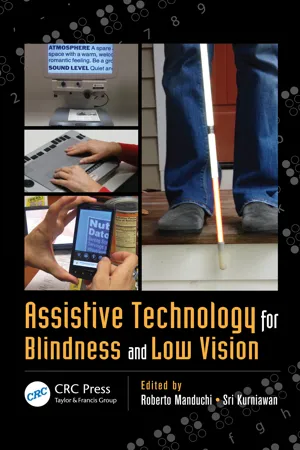
- 441 pages
- English
- ePUB (mobile friendly)
- Available on iOS & Android
Assistive Technology for Blindness and Low Vision
About This Book
Assistive technology has made it feasible for individuals with a wide range of impairments to engage in many activities, such as education and employment, in ways not previously possible. The key factor is to create consumer-driven technologies that solve the problems by addressing the needs of persons with visual impairments. Assistive Technology for Blindness and Low Vision explores a broad range of technologies that are improving the lives of these individuals. Presenting the current state of the art, this book emphasizes what can be learned from past successful products, as well as what exciting new solutions the future holds.Written by world-class leaders in their field, the chapters cover the physiological bases of vision loss and the fundamentals of orientation, mobility, and information access for blind and low vision individuals. They discuss technology for multiple applications (mobility, wayfinding, information access, education, work, entertainment), including both established technology and cutting-edge research. The book also examines computer and digital media access and the scientific basis for the theory and practice of sensory substitution.This volume provides a holistic view of the elements to consider when designing assistive technology for persons with visual impairment, keeping in mind the need for a user-driven approach to successfully design products that are easy to use, well priced, and fill a specific need. Written for a broad audience, this book provides a comprehensive overview and in-depth descriptions of current technology for designers, engineers, practitioners, rehabilitation professionals, and all readers interested in the challenges and promises of creating successful assistive technology.
Frequently asked questions
Information
Table of contents
- Cover
- Half Title
- Title Page
- Copyright Page
- Table of Contents
- Foreword
- Editors
- Contributors
- 1 Introduction
- 2 Vision and Vision Rehabilitation
- 3 Orientation and Mobility
- 4 Low Vision: Types of Vision Loss and Common Effects on Activities of Daily Life
- 5 Accessible Global Positioning Systems
- 6 Development, Evaluation, and Lessons Learned: A Case Study of Talking Signs® Remote Infrared Audible Signage
- 7 Evaluating the Effectiveness of Assistive Travel and Wayfinding Devices for Persons Who Are Blind or Visually Impaired
- 8 Sensory Substitution of Vision: Importance of Perceptual and Cognitive Processing
- 9 Tactile Reading: Tactile Understanding
- 10 Camera-Based Access to Visual Information
- 11 Screenreaders, Magnifiers, and Other Ways of Using Computers
- 12 Tools for Improving Web Accessibility for Blind Persons
- 13 Accessible DAISY Multimedia: Making Reading Easier for All
- 14 Math and the Blind
- 15 Video Games for Users with Visual Impairments
- 16 Descriptive Video Services
- 17 Employment, Technology, and Blind People: A Personal Perspective
- Index